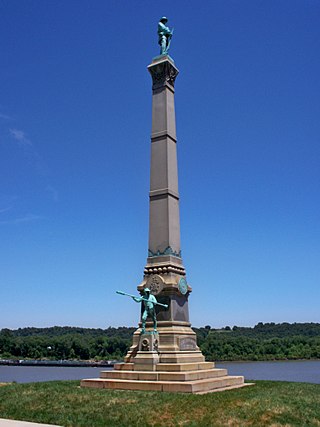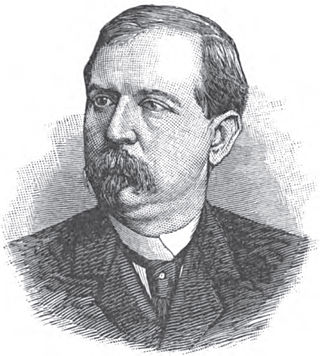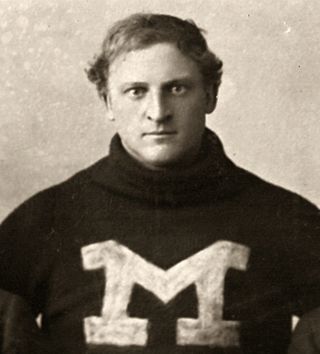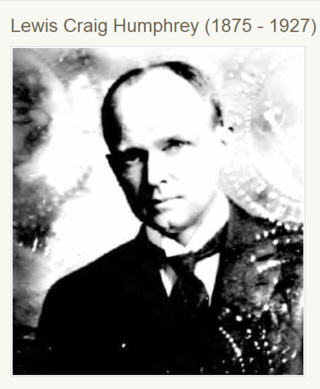Related Research Articles

John Griffin Carlisle was an American politician from the commonwealth of Kentucky and was a member of the Democratic Party. He was elected to the United States House of Representatives seven times, first in 1876, and served as Speaker of the House, from 1883 to 1889. He subsequently served as a U.S. senator from Kentucky, from 1890 to 1893, and then as Secretary of the Treasury, from 1893 to 1897, during the Panic of 1893. As a Bourbon Democrat he was a leader of the conservative, pro-business wing of the party, along with President Grover Cleveland.

The Abbey of Our Lady of Gethsemani is a Catholic monastery in the United States near Bardstown, Kentucky, in Nelson County. The abbey is part of the Order of Cistercians of the Strict Observance, better known as the Trappists. Founded on December 21, 1848, and raised to an abbey in 1851, Gethsemani is considered to be the motherhouse of all Trappist and Trappistine monasteries in the United States. Gethsemani is the oldest Trappist monastery in the country that is still operating.

William Lindsay was a Democratic U.S. Senator from Kentucky from 1893 to 1901.

The Big Four Bridge is a six-span former railroad truss bridge that crosses the Ohio River, connecting Louisville, Kentucky, and Jeffersonville, Indiana. It was completed in 1895, updated in 1929, taken out of rail service in 1968, and converted to bicycle and pedestrian use in 2014. The largest single span is 547 feet (167 m), with the entire bridge spanning 2,525 feet (770 m). It took its name from the defunct Cleveland, Cincinnati, Chicago and St. Louis Railway, which was nicknamed the "Big Four Railroad".

The Confederate Monument in Louisville is a 70-foot-tall monument formerly adjacent to and surrounded by the University of Louisville Belknap Campus in Louisville, Kentucky, United States. Relocation of the monument to Brandenburg, Kentucky, along the town's riverfront began November 2016, and was completed in mid-December. The granite and bronze structure was erected in 1895 by the Muldoon Monument Company with funds raised by the Kentucky Woman's Confederate Monument Association. The monument commemorates the sacrifice of Confederate veterans who died in the American Civil War.

Simmons College of Kentucky is a private historically black college in Louisville, Kentucky. Founded in 1879, it is the nation's 107th HBCU and is accredited by the Association for Biblical Higher Education.

Charles Finley was a United States representative from Kentucky and son of Hugh Franklin Finley.

Asher Graham Caruth was a U.S. Representative from Kentucky.

Forrest Maynard "Buck" Hall, sometimes listed as Forrest Maywood Hall and Forrest Mayward Hall, was an American football player and coach. He played college football at Princeton University in 1892 and 1893, and was a member of Princeton's undefeated 1893 national championship team. He served as the head football coach at Auburn University in 1894, compiling a record of 1–3, but also leading the team to the highest point total in school history, a 94–0 victory over Georgia Tech. He later played at the guard position for the 1895 Michigan Wolverines football team and for the Butte Athletic Club in 1896 and 1897. He also served as an assistant football coach at Michigan during the 1898 and 1909 seasons.

The French–Eversole feud occurred primarily from 1887–1894. The events occurred in the mountains of southeastern Kentucky and were mainly situated in Hazard, Perry County. The two instigators of this feud were Joseph C. Eversole and Benjamin Fulton French, who were both merchants and lawyers and at one time were friendly. The war or feud was a media sensation and was covered by many US papers at the time. The First report was in the Louisville Courier-Journal on June 30, 1886 on Page 1. A listing of the various media reports is included at the end of this article. Ultimately, those media reports became the basis for various books written about the French-Eversole War.
Charles F. Weaver was a mayor of Ashland, Kentucky and member of the Kentucky House of Representatives. Weaver was in the Kentucky Congress in 1895. He was also a stockholder in the Citizen's Telephone Company, which was incorporated in 1896. The Ashland Foundry & Machine Works, began by Daniel L. Weaver and William Wirt Culbertson was taken over by Weaver upon Daniel's 1894 death. Weaver operated the plant until his own death in 1932 and it continued to be under his estate.

Edward William Cornelius Humphrey, also known as "Alphabet Humphrey" and "Judge Humphrey", was a theological and legal scholar and influential member of the National Presbyterian General Assembly. A Harvard graduate with an honorary degree from Amherst, he was also an 1864 graduate of Centre College, of which he became a trustee in 1885. He was a trustee of the Louisville Presbyterian Theological Seminary and for forty-four successive terms was elected Director of the Louisville Law Library Company. He was a key figure in a long discussion and eventual acceptance of a Presbyterian creed revision held in May 1902 in New York City by the national Presbyterian General Assembly.

Lewis Craig Humphrey (1875–1927) was a prominent Kentucky newspaper editor who began his journalistic career as a reporter at the Louisville daily newspaper, the Louisville Evening Post, under the supervision of editor and publisher Richard W. Knott. Upon Knott's death, Humphrey became chief editor of the paper.

Joseph Castle Eversole was the assassinated leader of the Eversole side of the French-Eversole Feud. He had been also a delegate to the 1884 Republican National Convention.

Josiah Henry Combs was a lawyer and judge in Perry County, Kentucky. He was one of the central players involved in the French–Eversole Feud from 1887 to 1894 in Perry County. Combs was assassinated on September 23, 1894 in Hazard, the county seat.
The 1894 Kentucky State College Blue and White football team represented Kentucky State College—now known as the University of Kentucky—during the 1894 college football season. Led by W. P. Finney in his first and only season as head coach, the Blue and White compiled a record of 5–1.
The 1893 Kentucky State College Blue and White football team represented Kentucky State College—now known as the University of Kentucky—as an independent during the 1893 college football season. Led by John A. Thompson in his first and only season as head coach, the Blue and White compiled a record of 5–2–1.

The Kentucky State Penitentiary in Frankfort was the first prison built West of the Allegheny Mountains and completed June 22, 1800 when Kentucky was still virtually a wilderness. The Kentucky Legislature of 1798 had appointed Harry Innes, Alexander S. Bullitt, Caleb Wallace, Isaac Shelby and John Coburn as commissioners to choose a location for a “penitentiary house.” The house was described "to be built of brick, or stone, containing cells, workshops, with an outside wall high enough and strong enough to keep the prisoners from getting away." The site chosen was Frankfort, Kentucky. Henry Innis, one of the commission, gave one acre of land and the legislature appropriated $500 towards its building with more funds to be allocated later.

Margaret Anderson Watts was an American social reformer in the temperance movement, writer, and clubwoman. She was a deep thinker on the most advanced social and religious topics of her day, and occasionally published her views on woman in her political and civil relations. She was the first Kentucky woman who wrote and advocated the equal rights of woman before the law, and who argued for the higher education of woman. She served as president of the Woman's Christian Temperance Union (WCTU) of Kentucky, and as the National WCTU's Superintendent of police matrons.

James "Soup" Perkins (1879–1911) was born in Lexington, Kentucky, the son of former slaves. He and his entire family were involved in horse racing, training, and working in the stables. Perkins was the second youngest jockey ever to win the Kentucky Derby and the winningest jockey in America in 1895. At the peak of his career he earned $10,000 per year, the equivalent of $346,000 in 2022 US dollars and was written about in newspapers throughout the United States and Canada. He died at the age of thirty-three from a massive heart attack while working in Hamilton, Ontario, Canada.
References
- ↑ M. Raymond (1949). Burnt Out Incense. New York: P. J. Kenedy & Sons. pp. 240–242.
- ↑ Dunne, M. Frederic (1953). The Less Traveled Road. Milwaukee: Bruce Publishing Co]]. pp. 98–99.
- ↑ Aprile, Dianne (1998). The Abbey of Gethsemani: Place of Peace and Paradox. Louisville: Trout Lily Press. p. 101.
- ↑ "A Son's Almoner". Louisville Courier-Journal . November 14, 1893. p. 7.
- ↑ "Matters of Common Talk". Louisville Courier-Journal . December 24, 1893. p. 18.
- ↑ Sadliers Catholic Directory and Ordo. New York: D. & J. Sadlier and Co. 1894. p. 311.
- ↑ "Champions Mr. Beaufort". Louisville Courier Journal . May 19, 1894. p. 7.
- ↑ "About Darnley Beaufort". New York Times . October 21, 1894. p. 1.
- ↑ "Luxembourg, Registres d'état civil, 1796-1941," database with images, FamilySearch (https://familysearch.org/ark:/61903/3:1:S3HY-6P43-XWX?cc=1709358&wc=9RYZ-VZ9%3A129628601%2C129837501 : 17 July 2014), Bourscheid > Naissances 1797-1871 > image 1023 of 1296; Archives nationales de Luxembourg (National Archives), Luxembourg.
- ↑ Brentford Registration District, Middlesex, certified photocopy of marriage registration for Charles Luciens Adhemar Bernard Beaufort-Somneuil and Mary Elizabeth Pearde Furlong, 2 August 1890; Brentford Registration District, England.
- ↑ Delessert v. Bitterlin, 20 ATF 557 (Tribunal Fédérale Suisse 1894).
- ↑ "Boys Said to Be Cruelly Treated". Chicago Inter Ocean . November 28, 1894. p. 1.
- ↑ "Beaufort Deceived the Monks". Louisville Courier Journal . August 23, 1895. p. 1.
- ↑ "Revolting". Louisville Courier Journal . August 24, 1895. p. 1.
- ↑ "Darnley Beaufort Convicted". Louisville Courier-Journal . April 12, 1896. p. 12.
- ↑ "Beaufort's Second Case". Louisville Courier Journal . April 17, 1896. p. 8.
- ↑ "The Cases Will Be Filed Away". Louisville Courier Journal . April 28, 1896. p. 7.
- ↑ "Bullet Pierced His Cap". Louisville Courier Journal . February 10, 1898. p. 5.
- ↑ "Montgomery's Classic and Beautiful Homes". Montgomery Advertiser . December 11, 1910. p. 17.
- ↑ "Deaths, Burials - Cornelius Betz". Mobile News Item . September 3, 1930. p. 14.